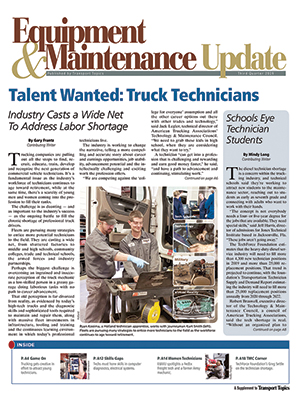Clear Career Paths Needed for Technicians

[Stay on top of transportation news: Get TTNews in your inbox.]
Creating a clear path for career advancement to help attract and retain diesel technicians is key to growing trucking’s pool of future leaders, industry experts said.
“There is a distinct path you can go from the bottom to the top,” said Darry Stuart, president of DWS Fleet Management Services. “Technicians today can go from the entry level to the highest level of managing a fleet.”
Mike Hasinec, vice president of corporate maintenance at Penske Truck Leasing, is among those in the industry who worked his way up the ladder. He started 41 years ago as a customer service representative at Penske, working on the fuel islands.
Recently, students at Universal Technical Institute’s Avondale, AZ, campus received a welcomed addition to the Diesel Tech program: a state-of-the-art #Penske sleeper: https://t.co/fzuDfXnC4K #DieselTech #Truck Maintenance — Penske Truck Leasing (@PenskeNews) July 18, 2019
Penske Truck Leasing is the parent company of Penske Logistics, which ranks No. 8 on the Transport Topics Top 50 list of the largest logistics companies in North America.
Penske has invested heavily in its in-house training, which starts at the lowest level with its technician certification program that provides training to those who haven’t completed a diesel technician program, Hasinec said. Technicians can advance to become a maintenance supervisor, then branch service manager, district service managers and, like Hasinec, vice president.
Penske offers several leadership training programs. The maintenance supervisor training program was designed for someone with three or more years of people management experience, said Ron Schwartz, vice president of staffing for Penske Truck Leasing, which is based in Reading, Pa. The structured program combines online learning, two weeks of training classes at the corporate office and side-by-side training with experienced managers.

- Talent Wanted: Truck Technicians
- Schools Eye Technician Students
- FutureTech Champ Advances Her Career
- Former Army Mechanic Is Now a Truck Tech
- Electric Trucks Will Demand New Expertise
- The Technician's Vital Role in Trucking
- Understanding the Numbers Behind the Shortage
- Trucking Gets Creative in Attracting Young Technicians
- Closing the Skills Gap: Techs Must Master Diagnostics, Electrical
Penske’s maintenance management trainee program is designed for those earlier in their career who don’t have leadership experience but are interested in maintenance management. It is a multimonth program and time varies based on how quickly the individual learns and demonstrates new skills. The program includes rotations through shop operations, front-facing customer engagement and people management.
Ryder also provides training for employees without diesel tech experience. Renee Fisher, director of recruiting for the company, said Ryder has several people who started on the fuel island and rose up to vice president.
“That is still very, very viable here,” she said.
Ryder’s techs move up through levels and then to technician-in-charge.
“You’re still working as a technician, but you’re the first level of management if they need help with other technical issues,” Fisher said, adding that the next level of management is a supervisor and then shop manager. “Those three are local to the shop, but we also have maintenance managers who have multiple shops under their belt.”
Beyond that is the director of operations and then regional vice president, Fisher said.
Ryder has a formal year-long program, called Future Leaders, that teaches management, communication and people skills along with some technical skills.
Job candidates look for opportunities to advance their careers when determining where to work, said Nick Thompson, director of field maintenance for Old Dominion Freight Line.
“About 85% of our current shop managers came from internal advancement,” Thompson said.
Old Dominion has created structured criteria for advancement that starts with its technicians.
“Whether it is a Tech I, Tech II or Tech III, at any point in time, they know what is required along the path and how to get to the next level. There are no surprises and no favoritism,” Thompson said.
Thomasville, N.C.-based Old Dominion Freight Line ranks No. 9 on the Transport Topics Top 100 list of the largest for-hire carriers in North America.
Old Dominion’s requirements include outside learning from manufacturers, live in-house training and half a dozen other requirements.
“Some of them are ‘plays-well-with-others’ requirements,” Thompson said, adding that Old Dominion offers training on leadership skills, such as situational leadership or supervisor communication.
Fleets said employees look for new opportunities through in-house postings and that managers also watch for those with leadership potential.
“If the manager sees potential, their natural role is to become an advocate for them,” Schwartz said, adding that Penske encourages techs to share their goals with their managers.
The time to progress up the ladder varies based on the individual and open opportunities.
“You generally need a couple of years under your belt to be a supervisor in some capacity,” Schwartz said.
Old Dominion’s Thompson said a Tech I right out of school who applies himself could move through the various tech levels in about a year and a half per level.
“In three and a half to five years they could be at the top of the scale if they apply themselves and have an aptitude,” he said, adding that moving through the supervisor or manager level ranks takes more time, in part because there are fewer positions.
Thompson said a tech could see a pay bump of 20% to 25% when going into management.
While pay varies by geography, at Penske, an entry-level tech could see a 40% to 50% pay increase after putting in three to five years and moving up to a maintenance supervisor, Schwartz said.
“Someone moving from a maintenance supervisor to a location maintenance manager would probably see another 20% increase,” he said.
Ryder’s technicians who advance past technician-in-charge move from hourly pay to a salary. Fisher said that results in a pay increase nine times out of 10, but for some, the bump is not as significant as others.
“If you’re eligible for overtime in hourly, you may be making a pretty penny,” she said. “For them, the interest in going over to a supervisory position isn’t always about the money.”
However, managing people isn’t for everyone.
“We need that group that wants to concentrate on the vehicles. There aren’t as many management roles,” DWS Fleet Management’s Stuart said.
Hasinec said about 80% of techs want to remain working with vehicles, but he said they value training and look for the opportunity to continue developing their skills.




